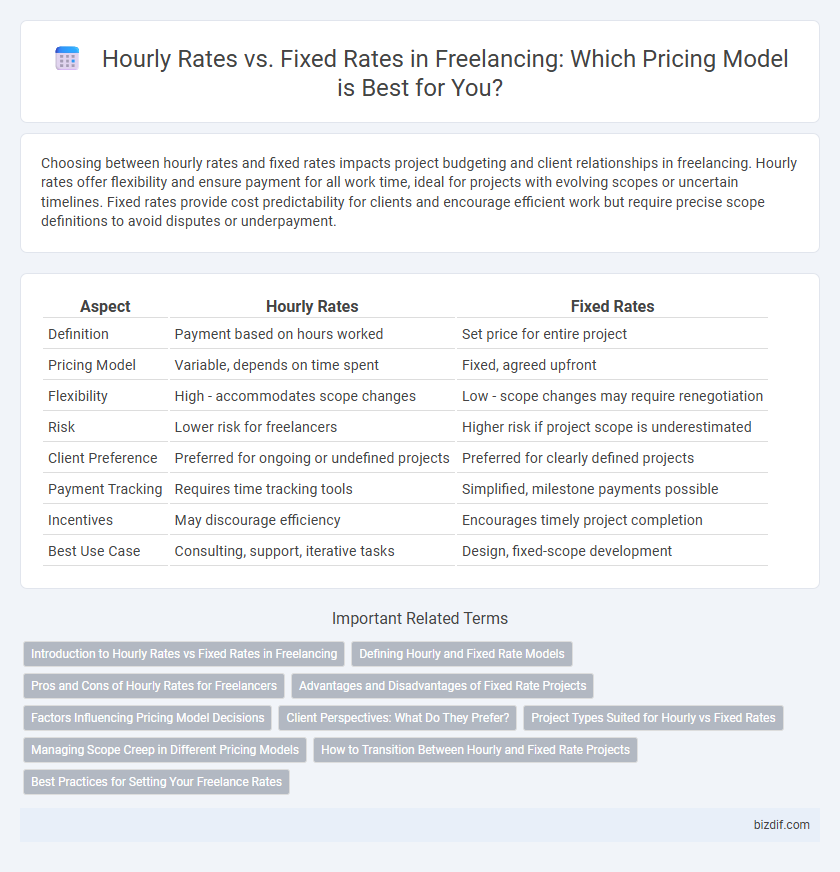Choosing between hourly rates and fixed rates impacts project budgeting and client relationships in freelancing. Hourly rates offer flexibility and ensure payment for all work time, ideal for projects with evolving scopes or uncertain timelines. Fixed rates provide cost predictability for clients and encourage efficient work but require precise scope definitions to avoid disputes or underpayment.
Table of Comparison
| Aspect | Hourly Rates | Fixed Rates |
|---|---|---|
| Definition | Payment based on hours worked | Set price for entire project |
| Pricing Model | Variable, depends on time spent | Fixed, agreed upfront |
| Flexibility | High - accommodates scope changes | Low - scope changes may require renegotiation |
| Risk | Lower risk for freelancers | Higher risk if project scope is underestimated |
| Client Preference | Preferred for ongoing or undefined projects | Preferred for clearly defined projects |
| Payment Tracking | Requires time tracking tools | Simplified, milestone payments possible |
| Incentives | May discourage efficiency | Encourages timely project completion |
| Best Use Case | Consulting, support, iterative tasks | Design, fixed-scope development |
Introduction to Hourly Rates vs Fixed Rates in Freelancing
Freelancers often choose between hourly rates and fixed rates to structure their payments, with hourly rates charging clients based on time spent and fixed rates setting a predetermined project price. Hourly rates provide flexibility for projects with uncertain scopes or ongoing work, while fixed rates offer clarity and budget control for defined deliverables. Understanding the pros and cons of each payment model is essential for maximizing income and managing client expectations effectively.
Defining Hourly and Fixed Rate Models
Hourly rate models charge clients based on the exact number of hours worked, offering flexibility for project scope changes and ensuring accurate compensation for time invested. Fixed rate models involve agreeing on a set price for the entire project, providing clients with clear budget expectations and motivating freelancers to complete tasks efficiently. Choosing between hourly and fixed rates depends on project complexity, client preferences, and risk management strategies in freelancing engagements.
Pros and Cons of Hourly Rates for Freelancers
Hourly rates offer freelancers flexibility to bill for actual time spent, ensuring fair compensation for variable workloads and project scope changes. This payment model allows transparent tracking of work hours but may lead to client concerns about efficiency and escalating costs. Freelancers risk income unpredictability due to fluctuating hours, and time spent on non-billable tasks reduces overall profitability.
Advantages and Disadvantages of Fixed Rate Projects
Fixed rate projects offer clear budget expectations and simplify client invoicing, making them ideal for well-defined tasks with predictable scope. They provide freelancers with the security of a guaranteed payment regardless of time spent but can lead to potential losses if the project requires more effort than estimated. Inflexibility in accommodating scope changes often causes disputes or scope creep, necessitating precise project specifications and contract terms.
Factors Influencing Pricing Model Decisions
Freelancers often choose between hourly rates and fixed rates based on project scope, complexity, and client risk tolerance. Hourly rates offer flexibility for uncertain or evolving tasks, while fixed rates provide predictable costs for well-defined deliverables. Client budget, project duration, and freelancer experience also significantly impact the optimal pricing strategy for maximizing profitability and client satisfaction.
Client Perspectives: What Do They Prefer?
Clients often prefer fixed rates for project budgets as they offer cost predictability and clear financial planning, especially for well-defined tasks. Hourly rates are favored when project scope may shift or require ongoing adjustments, allowing flexibility and transparency in billing based on actual work done. Understanding client priorities--whether stability or adaptability--helps freelancers align pricing models to improve project satisfaction and trust.
Project Types Suited for Hourly vs Fixed Rates
Hourly rates are ideal for projects with uncertain scopes or evolving requirements, such as ongoing consulting or maintenance work, where tracking time ensures fair compensation for fluctuating workloads. Fixed rates suit well-defined projects with clear deliverables and timelines, like website design or content creation, enabling clients to budget accurately and freelancers to optimize efficiency. Choosing the appropriate payment method depends on project complexity, scope stability, and the level of control needed over time and cost.
Managing Scope Creep in Different Pricing Models
Managing scope creep effectively requires clear communication and well-defined project boundaries in both hourly and fixed-rate freelancing models. Hourly rates offer flexibility to accommodate adjustments, minimizing disputes over extra work, while fixed rates demand precise scope detailing upfront to avoid costly overruns. Utilizing tools like detailed contracts and milestone tracking helps freelancers maintain control over project scope regardless of the chosen pricing structure.
How to Transition Between Hourly and Fixed Rate Projects
Transitioning from hourly to fixed rate projects requires evaluating the scope and complexity of tasks to accurately estimate time and resources. Establish clear milestones and deliverables within the fixed rate contract to avoid scope creep and ensure client expectations align with project outcomes. Utilize time-tracking data from previous hourly projects to inform pricing strategies and negotiate fair fixed rates.
Best Practices for Setting Your Freelance Rates
Freelancers should evaluate project scope, client budget, and market demand when choosing between hourly and fixed rates to ensure fair compensation. Setting transparent rates includes calculating all costs such as taxes, software, and downtime, ensuring sustainable profitability. Communicating clear payment terms and regularly reviewing rates based on experience and industry standards enhances client trust and long-term success.
Hourly Rates vs Fixed Rates Infographic

 bizdif.com
bizdif.com